Single-Session Therapy

‘Single-session therapy’ (SST) is a therapy format that started in the U.S. at the beginning of the nineties. It can be related to any psychotherapeutic school or no school. The focus lies as much as possible on empowering the client.
This accords with the Aurelian focus on inner Strength. Other Aurelian values (openness, depth, respect, freedom, trustworthiness) are also applicable.
SST (*) should not rigidly mean that only one session is offered.
On the other hand, each session – including the first – is potentially seen as the last. Therefore, this one session (‘one at a time’) should be as effective as possible, with effects that are meant to be evident over a much longer period.
If needed, there can always be a next session ― in the same vein. This attitude effectively puts the client in the driver’s seat. He is shown how to drive (safely) and then is left free to do so. A well-known phrase captures this as: ‘Only you can do it, but you don’t have to do it alone’.
One may see this as ‘nudging’ the client in the right direction. After a while, he may receive another nudge to keep him in the right direction, which he chooses himself.
Intriguingly, in one study in which people were given the choice to attend one session of therapy, most of them did so and most of these reported significant improvement in the problem for which they sought help. (**) However:
SST is more than just a short form of therapy.
It is nothing like condensing standard therapy into one session. Actually, that would have no chance of working. Additionally, it might damage people by enforcing them into a superficial straitjacket.
The core of SST should be a specific mindset that respects the depth of human experience. The SST format is a natural consequence if that mindset is correctly practiced. Part of the mindset is that there is no need for many sessions if the client can optimally use the inner resources that are already present. It thus shows a deep belief in the client’s possibilities that mainly stem from subconceptual processes.
If not realized – and the client needs more sessions – this also entails that no sense of guilt or shortcoming is heaved upon either side of the therapeutic relationship. This, by itself, is already a profound insight and source of learning.
Superficial SST will not be cost-effective.
In the former, I briefly described deep SST. This demands a lot of the therapist and – if any – the organization providing it.
SST should not merely be a logistical arrangement. Crucially, if SST is brought with the aim of being cost-effective (‘speeding up therapy’), depth is almost certainly challenging and probably absent. In that case, the client’s change is superficial and not growth-oriented. The deeper problem remains and resurfaces with a vengeance. As a result, over the years, such clients will be costlier through this kind of SST.
To avoid this, one must uphold the highest standards of ethical practice by not compromising on the quality of therapeutic engagement. This is, ensuring that clients receive care that is both effective and morally sound.
Deep SST is interesting.
Even so, it should be seen on a case basis. The therapist and client need to be ready. The primary expertise of the therapist then lies in making the client his own expert, kindling his own growth process from within. This may mean sometimes much, sometimes little. It always means emphasizing a non-coercive approach that respects the client’s journey toward true change, being growth from the inside out. It means support, no pressure ― which may, at first sight, seem contradictory to ‘single session.’
This approach is also deeply rooted in AURELIS values of respect and freedom, ensuring that the therapy does not coerce but gently guides the client toward self-discovery and self-reliance. Contrary to what one might think in SST, this doesn’t mean there is a fleeting-thus-less-profoundly-empathic contact between therapist/coach and client. The contact needs to be swiftly profound.
The SST therapist who thinks this can be achieved without becoming an artist doesn’t get it. As in any good art, broad and profound mental patterns need to be captured ― also specifically a deeply Aurelian undertaking.
The organization (such as social insurance) that thinks this is an easy way to make money will eventually lose. Also, the clients and society will lose.
Lisa?
Lisa (see that category) is designed to assist clients in navigating their mental landscapes, helping them uncover and utilize their resources and capabilities in a way that promotes autonomy and personal development.
In this sense, SST can be a powerful tool in Lisa’s toolbox. Of course, Lisa is available 24/7, as are other AURELIS online tools. Is SST still relevant since, after all, Lisa can easily provide many coaching sessions? Yes, it is because the core is mainly a mindset. Already, there is congruence. Therefore, it’s a question of getting sharper in Lisa-SST for which there are specific indications, such as when there is a clear and single focus and a need to rapidly progress on this one.
On the other side, will Lisa be capable of performing deep SST?
In my view, not yet, but definitely, yes, soon enough.
―
(*) A good book about SST: Single-Session Therapy (SST): 100 Key Points and Techniques – Windy Dryden, 2024
(**) Hoyt, M. F., Rosenbaum, R. & Talmon, M. (1992). Planned single-session psychotherapy. In S. H. Budman, M. F. Hoyt & S. Friedman (Eds.), The First Session in Brief Therapy (pp. 59–86). New York: Guilford Press.


